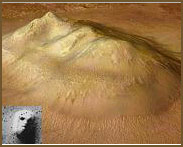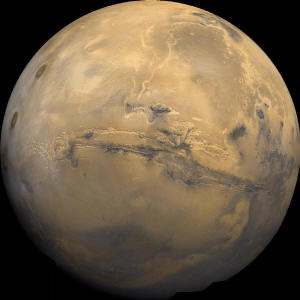
|  |

 UPDATE: September 2006: A new view of Mars' mountainous Cydonia region, sire of the famous "Face on Mars," from the European Space Agency's Mars Express craft. Inset is an image of the place from NASA's Viking 1 mission, which convinced a generation of space enthusiasts that aliens had sculpted a giant face. Scientists called it an illusuon due to shadows. The raised zone is about 4.2 km (2.6 miles) across as seen in the main image. (Courtesy ESA). UPDATE: September 2006: A new view of Mars' mountainous Cydonia region, sire of the famous "Face on Mars," from the European Space Agency's Mars Express craft. Inset is an image of the place from NASA's Viking 1 mission, which convinced a generation of space enthusiasts that aliens had sculpted a giant face. Scientists called it an illusuon due to shadows. The raised zone is about 4.2 km (2.6 miles) across as seen in the main image. (Courtesy ESA).
|
ViewZone asks three experts to bring us up to date on this persistent claim...
 Eric C. Lausch is college student and a FACETS
memeber. He loves motorcycles and is involved with numerous
motorcyclist right's organizations. He loves his Harley Davidson and pretty girls. He thinks Mars is kinda cool too. He is notorious in the Mars anomaly resaerch community for being a BAD influence on mars researchers of either gender.
Eric C. Lausch is college student and a FACETS
memeber. He loves motorcycles and is involved with numerous
motorcyclist right's organizations. He loves his Harley Davidson and pretty girls. He thinks Mars is kinda cool too. He is notorious in the Mars anomaly resaerch community for being a BAD influence on mars researchers of either gender. |
 Richard C. Hoagland is a former Space program
consultant to Walter Cronkite and CBS news, a former
planetarium director, a published author ("The
Monuments of Mars") and a recipient of the Angstrom
Medal for Excellence in Science.
He heads the independent non -profit organization the
Enterprise Mission. Richard C. Hoagland is a former Space program
consultant to Walter Cronkite and CBS news, a former
planetarium director, a published author ("The
Monuments of Mars") and a recipient of the Angstrom
Medal for Excellence in Science.
He heads the independent non -profit organization the
Enterprise Mission. |
David Jinks is the Founder of the Formal Action
Committe for Extraterrestrial Studies (FACETS) , the
group that entered into litigation with NASA and
forced the re-imaging of the Face at Cydonia and five
other sites which have still to be delivered by
NASA\JPL\MSSS. He is the author of several books including "The
Monkey and the Tetrahedron" |
| Questions & Answers: A Case For the Face.
ViewZone: Since the discovery of the "face," I understood that NASA had sent another probe that took photographs and radar scans of the area and revealed it to be a large sand dune or hill, with no signficiant shape. Is this true? |
|
Lausch: The Face was originally photographed by Viking in the 1970's. The Mars Global surveyor reimaged it in 1997 and again last year as a result of the FACETS litigation.
The jury is still out. Additional images have raised more questions than they've produced answers. Further scientific inquiry will be needed to resolve this issue.
NASA/JPL/MSSS have not been entirely cooperative on this issue.
|
|
Hoagland: No, no data other than B&W images have been
returned. And, there has NEVER been radar on a U.S.
or Russian Mars spacecraft to date. There WILL be ...
in the future.
|
|
Jinks: No. The "face" is clearly neither a sand dune or hill. It's a rocky mesa. Mars Global Surveyor images in 1998 and 2001 confirm the same details appearing in the 1976 Viking images. The most significant details are a 98% symmetric base, and a plethora of "facial" features, which were predicted on the basis of prior images. Prediction is the hallmark of science. See former U.S. Naval Observatory Celestial Mechanics director Dr. Tom Van Flandern's web site for more information on this key point. (see http://www.metaresearch.org/solar%20system/cydonia/2001_Face/Preliminary.htm).
There has been no radar imagery taken of the "face." However, Mars Orbiter Laser Altimetry (MOLA) data has been acquired. The MOLA data confirms prior predictions by Dr. Mark Carlotto. In denouncing the "face" once again, it has been shown that NASA drew errant conclusions from the MOLA data, and possibly even used the wrong data, in its haste to put an end to the "face" controversy. See NASA contractor and engineer Lan Fleming's analysis of the latest NASA blunder here: http://www.metaresearch.org/solar% 20system/cydonia/2001_Face/Preliminary.htm
|
|
ViewZone:If this is indeed a "face" then what is it a face of exactly? |
|
Lausch: In the early '90's Hoagland postulated that it was a hominid-feline hybrid. Similar to Mayan split faced glyphs that have been found on various archaeological digs. Hoagland based his prediction on scanty imaging analysis from the Viking images.
Further imaging has borne out his conclusions. Whether by design or catastrophe, his analysis is the most compelling I've seen.
|
|
Hoagland: A hominid/feline combination -- a two-species
duality ... like many similar archaeological examples
here on Earth! This duality -- first proposed by
Hoagland at the UN in 1992 -- was resounding confirmed
by the latest NASA "full face" image: April 8, 2001.
|
|
Jinks: It is not clear. But the question is one of artificiality, not of meaning. The "face" has a sufficient number of anomalous properties to tilt the evidence in favor of artificiality, regardless of what its artistic purposes are. Consider Mount Rushmore in a thousand or 10,000 years...would it be clear who or what it memorialized? Probably not. But evidence of its carved nature would probably be evident. The case may be
the same for the "face." In my opinion, the strongest hypothesis regarding meaning at this point is the dual hominid/feline symbolism espoused by Hoagland. I conclude this because the facial detail is not symmetrical, but there appears to be a horizontal eye, a broad nose bridge and a meandering, "muzzle" type mouth, consistent with the leonine interpretation. However, based on the unusual "melted" appearance of the "face's" east side, Van Flandern concludes that the east side has been distorted severely. If this is true it might be impossible to know how it looked originally. Only more images, preferably high-resolution color or thermal, will reveal further artificiality. Things we might look for are supports, evidence of tooling, or anomalous materials. We need more data than that NASA has been willing to provide. Mars Odyssey should give us additional data, assuming NASA keeps its promise, something the space agency has not been good at doing in vis-a-vis the "face" mesa.
|
|
ViewZone: What is the probably reason for constructing the face like this? |
|
Lausch: Well, it was obviously built to be viewed from above, either from an aerial conveyance or possibly from another heavenly body. There is a theory that Mars was the water moon of a planet that broke up and subsequently became the asteroid belt.
Why did the makers of the Nazca lines create ideograms that could only be fully realized from far , far above the dusty plains of South America? I don't know-but I'm damn sure curious.
I could no sooner speculate why the Sphinx was built in at Giza or whose physiognomy it resembles.
A memorial of some type, I'd assume.
|
|
Hoagland: To immortalize some kind of "hybrid genetic
experiment" carried out on Mars by "someone." The
purpose may have been to fuse specific genetic
qualities of the hominid/feline species into one
"new species."
|
|
Jinks: The "face," assuming it's artificial, was probably constructed for the same reason we construct monuments: to memorialize ("set in stone") a significant event, and perhaps to send a message (an "SOS") to future generations.
|
|
ViewZone: What other anomalies are in the area that likely belong to the same complex? Do these have any unique alignment with the Martian poles etc? |
|
Lausch: Cydonia has a plethora of interesting features that require further investigation. A collection of large buttes or massifs are found geographically adjacent to the Face.
Some of them bear a striking similarity (on a far larger scale) to terrestrial analogs such as the Giza complex in Egypt.
They appear to be laid out in a geometrically significant relationship to one another.
Richard Hoagland has theory that basically says the Cydonia complex was designed and built around an underlying mathematical concept that he terms "hyper dimensional physics".
Dr. Horace Crater of the University of Tennessee Space
institute has done a statistical analysis on a series of mounds in the Cydonia Mensae region. His analysis shows that these mounds are distributed on a pattern based on the square root of two! Now I find that fascinating. This doesn't occur in nature as far as our experience goes.
Also, apparently the Cydonia region was once situated upon the Martian equator prior to Mar's last pole shift. Dr. Tom Van Flandern is the real expert in this area of cultural significance.
|
|
Hoagland: A set of massive pyramids and other highly
geometric structures -- linked by an equally complex
network of repeating mathematical and geometric
alignments. And, yes, some of these relationships
relate not only to the Martian pole, but to the
Martian equivalent of the "Martian nautical mile."
Full details can be found in "The Monuments of Mars" A
City on the Edge of Forever" (Hoagland, R.C., North
Atlantic Books, Berkeley, CA, 2001, Fifth Edition).
Check out www.enterprisemission.com as well.
|
|
Jinks: Hoagland has proposed some alignments in The Monuments of Mars. Dr. Horace Carter has corroborated the wholly unexpected presence of a significant angle, 19.5 degrees, in computer simulations of nearby anomalous "mound" features. See Hoagland/Crater links at:
http://www.infosourceresearch.com/artifacts/cydonia.html
These numerical connections were made after-the-fact, meaning they could be coincidence, but some of them, such as those found in the gigantic, faceted and buttressed "D&M Pyramid," are compelling. Their presence, along with the bizarre nature of the "face," support the artificiality hypothesis, but they don't prove it. Interestingly, Van Flandern showed that astronomical data strongly suggests the "face" used to be very close to being upright on Mars' equator prior to its latest mainstream-accepted "pole shift."
|
|
ViewZone: What future events will eventually resolve this issue? |
|
Lausch: The Mars Odyssey has just finished aerobraking maneuvers and is settling into the science phase of it's mission. It has the ability to return data that can differentiate between the composition of different materials based on spectrometry.
If dissimilar materials were used (as one would expect in an artificial construct-based on our terrestrial experience) then it may be possible to delineate between the "building blocks of an edifice" and a naturally occurring geological feature.
The ESA's Mars Express due to arrive in 2003 is equipped with a suite of instruments whose capabilities cover a far broader spectrum of scientific analysis than any NASA has sent aboard it's probes.
Ground penetrating radar for one (similar to that which the military uses
to find underground bunkers). It can penetrate up to a kilometer beneath the surface of Mars as I understand it. This instrument should reveal any hidden chambers in above ground massifs or underground construction beneath the Martian megalith.
Hopefully the scientific data will be freely available for all to examine.
|
|
Hoagland: NASA has just announced (January 21, 2002) a plan
to acquire new high-resolution IR and visible light
imagery of "the Face" with the new Mars spacecraft
currently in orbit: Mars Odyssey. This may resolve
certain outstanding problems that the previous B&W
imagery could not. In future missions, even
higher-resolution color imagery will be returned, as
well as the first RADAR scans. These observations
should finally resolve the "artificiality" question to
most observers' satisfaction.
|
|
Jinks: First, NASA has to be willing to consider the artificiality hypothesis. So far it hasn't done a single dated, authored study on this possibility, despite the 25-year involvement, in this issue, of a dozen or more highly credentialed scientists outside of NASA. (Actually, some investigators are or were on contract to NASA, but officially, the space agency has never acknowledged them or their work as valid.) Mars Odyssey should get more high-res images, and NASA has in fact promised that recently. We need images from different angles, and we need images of nearby objects such as the "D&M Pyramid". The European Space Agency and other agencies may provide the final evidence needed to put to rest the issue of artificiality, if NASA doesn't. The final determination will be made by the nature of the preponderance of the evidence, and three images in almost 30 years is not enough to make a final decision on whether the "face" is artificial, although NASA seems content to call it natural. That is a premature conclusion, at best.
|
|
ViewZone: Are there any additional anomalies like this that will likely be significant in the future? |
 Valles Marineris, a heretofore inexplicable trough extending
one quarter of the circumference of Mars, is the largest canyon in the
Solar System. The authors submit that this a fluvial trench generated
by tidal bore action during Mars' "captured satellite" phase. [from Hoagland's web site listed below] |
|
Lausch: Yes, I believe so. Various scientific instruments have returned data that is totally surprising considering the official NASA\JPL\MSSS position on the planet Mars. The tubes (which Mr. Hoagland refers to as glass tunnels) are of particular interest. I am presently involved with a group of researchers who are mapping various imaging anomalies against other scientific data. Some interesting correlations are appearing. Time and further study should prove interesting.
I would welcome some answers to these curiosities in my lifetime.
|
|
Hoagland: The previous NASA mission (still orbiting Mars
and taking images) -- Mars Global Surveyor -- has
returned upwards of 70,000 images of Mars to date. On
literally thousands of these images, striking
artificial-looking structures have been found.
Requests to NASA to take second and third confirming
images have, so far, been ignored .... Again,
examples of these striking images can be found at
www.enterprisemission.com.
|
|
ViewZone:What is a probable explanation for the disappearance of life on Mars? |
|
Hoagland: A massive planetary disaster. One carefully
detailed, scientific model for this cataclysm can be
found at: http://www.enterprisemission.com/tides.htm
RCHoagland
|
|
Lausch: Who says it's gone?
I'm not joking.
Scientists are taking another look at biological
experiments from the Viking landers in the '70's.
Several now agree that the Viking experiments did
indeed show signs of biological activity.
I find it curious that the same data produces a
different conclusion 25 years later......but that's
another issue.
There's a researcher named Baker at the University of
Arizona.
He has a theory that Mars has warm wet periods (say of
a few thousand years) interspersed into the longer,
cold dry periods.
Presently , MGS Thermal Emission spectrometer data
shows a temperature of around 71 degrees Fahrenheit at
45 degree south latitude on Mars.
That's downright balmy! Plenty warm enough for liquid
water. The southern Polar Cap has shrunk steadily during the
mapping phase of the MGS mission, shrinking by
approximately one-third!
Mars may simply be waking up from hibernation after a
long winter's nap.
I'd say by 2005 we should have enough data to end all
the speculation about what's really happening on Mars.
Then we'll need to send a manned mission to prove out
our hypotheses.
I hope it happens in my lifetime.
|
|
The Cydonian Imperative
2-12-02
Correction on Page 27
by Mac Tonnies
http://mactonnies.com/cydonia.html
[Update (2-12-02): I was mistaken in implying that the
Gamma Ray Spectrometer could resolve the Face. The
instrument in question is actually the complimentary
THEMIS instrument suite, as pointed out by Richard
Hoagland and Mike Bara on The Enterprise Mission's
latest article:
"THEMIS is actually three instruments in one; the
visible light camera, a thermal imager, and a
multi-spectral imager--or infrared camera. The
infrared camera can scan the planet's surface at 100
MPP resolution, but with a sensitivity of one degree
difference in temperature. The same infrared
instrument, by scanning in nine different region of
the IR spectrum, will allow determination of the
surface composition of the objects that it scans...at
that same 100 meter/pixel resolution. (Some web sites
have stated that the Gamma Ray Spectrometer will
reveal the most detail about the Face, but this is not
correct. The GRS has a resolution of only 300
kilometers per pixel, substantially worse than the
THEMIS)."
On the other hand, the GRS is able to penetrate to a
depth unreachable by THEMIS. Hopefully future
instruments, such as the radar suggested by Mark
Carlotto, will improve on the Odyssey's instrument
package, making a directed search for artificial
structure more viable --M.T.] |
ViewZone || Comments?
|  | |


 Eric C. Lausch is college student and a FACETS
memeber. He loves motorcycles and is involved with numerous
motorcyclist right's organizations. He loves his Harley Davidson and pretty girls. He thinks Mars is kinda cool too. He is notorious in the Mars anomaly resaerch community for being a BAD influence on mars researchers of either gender.
Eric C. Lausch is college student and a FACETS
memeber. He loves motorcycles and is involved with numerous
motorcyclist right's organizations. He loves his Harley Davidson and pretty girls. He thinks Mars is kinda cool too. He is notorious in the Mars anomaly resaerch community for being a BAD influence on mars researchers of either gender. Richard C. Hoagland is a former Space program
consultant to Walter Cronkite and CBS news, a former
planetarium director, a published author ("The
Monuments of Mars") and a recipient of the Angstrom
Medal for Excellence in Science.
He heads the independent non -profit organization the
Enterprise Mission.
Richard C. Hoagland is a former Space program
consultant to Walter Cronkite and CBS news, a former
planetarium director, a published author ("The
Monuments of Mars") and a recipient of the Angstrom
Medal for Excellence in Science.
He heads the independent non -profit organization the
Enterprise Mission.

 UPDATE: September 2006: A new view of Mars' mountainous Cydonia region, sire of the famous "Face on Mars," from the European Space Agency's Mars Express craft. Inset is an image of the place from NASA's Viking 1 mission, which convinced a generation of space enthusiasts that aliens had sculpted a giant face. Scientists called it an illusuon due to shadows. The raised zone is about 4.2 km (2.6 miles) across as seen in the main image. (Courtesy ESA).
UPDATE: September 2006: A new view of Mars' mountainous Cydonia region, sire of the famous "Face on Mars," from the European Space Agency's Mars Express craft. Inset is an image of the place from NASA's Viking 1 mission, which convinced a generation of space enthusiasts that aliens had sculpted a giant face. Scientists called it an illusuon due to shadows. The raised zone is about 4.2 km (2.6 miles) across as seen in the main image. (Courtesy ESA).